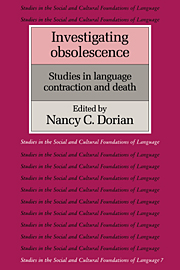Book contents
- Frontmatter
- Contents
- List of maps
- List of contributors
- Preface
- Map
- Dedication
- Introduction
- I Focus on context
- II Focus on structure
- 11 Problems in obsolescence research: The Gros Ventres of Montana
- 12 The structural consequences of language death
- 13 On signs of health and death
- 14 Case usage among the Pennsylvania German sectarians and nonsectarians
- 15 Estonian among immigrants in Sweden
- 16 The incipient obsolescence of polysynthesis: Cayuga in Ontario and Oklahoma
- 17 Urban and non-urban Egyptian Nubian: Is there a reduction in language skill?
- 18 Some lexical and morphological changes in Warlpiri
- 19 Language contraction and linguistic change: The case of Welland French
- 20 Lexical innovation and loss: The use and value of restricted Hungarian
- III Invited commentaries
- Bibliography
- Index of languages
- General index
13 - On signs of health and death
Published online by Cambridge University Press: 08 January 2010
- Frontmatter
- Contents
- List of maps
- List of contributors
- Preface
- Map
- Dedication
- Introduction
- I Focus on context
- II Focus on structure
- 11 Problems in obsolescence research: The Gros Ventres of Montana
- 12 The structural consequences of language death
- 13 On signs of health and death
- 14 Case usage among the Pennsylvania German sectarians and nonsectarians
- 15 Estonian among immigrants in Sweden
- 16 The incipient obsolescence of polysynthesis: Cayuga in Ontario and Oklahoma
- 17 Urban and non-urban Egyptian Nubian: Is there a reduction in language skill?
- 18 Some lexical and morphological changes in Warlpiri
- 19 Language contraction and linguistic change: The case of Welland French
- 20 Lexical innovation and loss: The use and value of restricted Hungarian
- III Invited commentaries
- Bibliography
- Index of languages
- General index
Summary
When a language, or reasonably isolated dialect, appears to be “on the way out” one might hope to find some traits or symptoms that would be interesting to watch. Nancy Dorian, in her numerous and seminal publications (1981 and refs. there cited), has in fact done just this in greater detail and with greater responsibility than anyone else. Over a goodly number of years I have collected data from living dialects for a number of purposes, often for more than one reason: in order to document a rare variety of a language for ultimate historical and comparative linguistic ends (e.g. North Geg Albanian or Vannetais Breton), to fill in the dialectology of a language (Tetovo Albanian, various sorts of Scottish Gaelic), to explore the manifestations of language contact and multilingualism (Prespa Albanian, Arvanìtika of younger speakers of Attica, Resia Slovene, Tiefencastel Romauntsch, Aromân / Koutsovlah, Mandrítsa Albanian), to verify the presence of a language (Màndres Albanian, Arbanasi Albanian at Zadar, various Albanian enclaves of Arbresh in southern Italy and Arvanìtika in Greece). I restrict the content of this chapter and the above mentions to dialects of Europe in order to give our discussion a degree of cultural and situational homogeneity, as well as to maximize the presentation of substance in a short space. In numerous such situations I have found myself observing societies with only vestigial groups of speakers or semi-speakers, and with predictably ultimate terminal heirs of the native language.
To make our topic manageable and to explore a consistent segment of linguistic structure, the ensuing observations will be restricted to phonology, including phonetics.
- Type
- Chapter
- Information
- Investigating ObsolescenceStudies in Language Contraction and Death, pp. 197 - 210Publisher: Cambridge University PressPrint publication year: 1989
- 16
- Cited by



